JARS v63n3 - The Trott Garden on Canterbury Plains, New Zealand
The Trott Garden on Canterbury Plains,
New Zealand
Frances Burns
Vida, Oregon
Turn the globe to "down under"; locate GPS 43° 53' S and 171° 48' E, and that would be Ashburton, on the
east side of South Island southwest of Christchurch, New Zealand (NZ). This small town is situated on the
Canterbury Plains, the center of an agricultural area producing cultivated crops, dairy cattle and sheep.
Here, farmers always save a hectare to plant a garden where sheep are not allowed; and every home appears
to have a garden, quite British in style. Warmly hospitable gardeners may offer their guests homemade
delights such as cucumber sandwiches, petits fours, bracing hot tea, and cold lemonade. Travelers thus
enticed categorically schedule return trips to New Zealand!
Now travel five kilometers from Ashburton (an hour from Christchurch) to one of the South Island's
"premier establishments," which won the Award of Garden Excellence from the Canterbury Horticultural
Society in 2001. Alan and Catherine Trott are the proprietors of this unique garden and "boutique" nursery
carrying a wide choice of discernible plants. A focused, high energy, and genial man, Alan is living his
lifelong dream. His property is a year-round panorama of beauty with rhododendrons and camellias spilling
their blooms in the spring; tree leaves shimmering in the summer breeze among flowering perennials,
glorious autumn color, and the haunting silhouette of conifers, deciduous trees, and ornamental grasses
in winter.
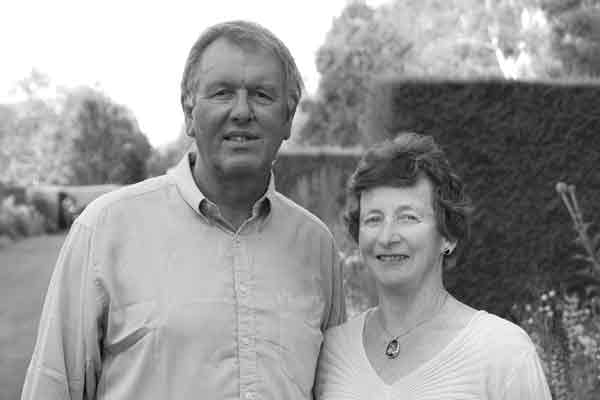 |
| Alan and Catherine Trott. Photo by Alan Trott |
The obvious planning and picture book care of the garden may lead some to think of wealth and inheritance.
Not so! In the words of Alan Trott, "Some think we are millionaires with this grand estate, but far from it.
We have done every bit of it from nothing and no money." Would it be possible in today's economy? Alan's
reply is, "I say if you dream and ponder you will get no where. Be positive!"
Alan and Catherine were both born and raised in New Zealand, just 50 kilometers apart. His father was foreman
at a local freezing plant processing 9000 lambs a day, but found pleasure puttering in his vegetable garden
after work. His Mum is now 88, is fit and has never gardened. So Alan is not sure where he fit into the scheme
of things. Living through the hard times of the Big Depression and World War II, his parents produced only
one "garden nutter" out of five children. The Trott's three sons, ages 29, 31 and 33, have no interest in
taking over the garden one day. Alan, who has grown plants as long as he can remember, adds, "They probably
had enough when they were young as they certainly were carted in the pram around gardens from an early age".
This passion for gardening has draw interesting folks from all walks of life the world over to the Trott garden.
Alan states, "It does not matter what you do. When folk ask what I do, I say, 'I'm just a gardener!'" Alan
continues, "Some say little and think I must be a bit simple, others light up, so interested in what we have
achieved here." This is a man with clear goals, none of which includes hybridizing. He once grew plants from the
ARS seed catalog, "but I have not had the spare room to line them all out. There are so many good named
varieties available and less time is needed to get them into flower. At that stage I was more interested
in creating a garden." Nor does he take his rhododendrons trusses to garden shows, as they are "too far
away to do that." He prefers that people view the garden as a show bench, and an opportunity to enjoy
and learn about gardens. Their recent nursery exhibit at the Ellerslie International Flower Show in
Christchurch garnered them a gold medal, "so that's out of our 'too hard basket' now and we are back to
normal." Alan observed.
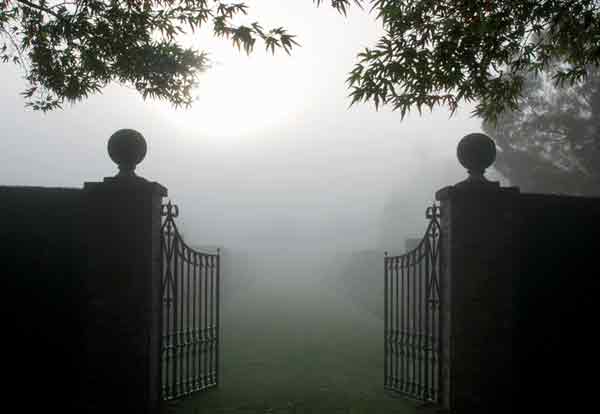 |
| Autumn fog at the entrance to the garden. Photo by Alan Trott |
In the 1960s, just out of school, Alan's horticultural interests were sparked by Helen and Graham Holmes,
whose large garden included rhododendrons grown from seed imported from the US and UK. Several of their
Holmeslee hybrids are listed in the Second Edition of Rhododendron Hybrids by Homer Salley and Harold
Greer. Another huge inspiration to Alan's future were Mollie and Ivan Wood, who were both Eugene ARS chapter
members. Mollie grew azaleas and rhododendrons from Ilam seed, generously sharing cuttings and ARS
quarterlies with Alan. After Ivan died, Mollie married R. J. Coker, a rhododendron man from Christchurch,
and also a long-time member of the Eugene Chapter. A good team, they traveled to the United States
many times.
Alan joined the NZ Rhododendron Association in 1968, but it was Mollie's influence that led him to join the ARS
also in 1968. He became a life member in 1978, and shortly after that, a member of Eugene Chapter. Alan was
President of the New Zealand Rhododendron Association for three years and is a life member of the International
Dendrology Society. In his words, "I am not really involved in much at present as we are busy here and there
are other things I want to do like learning to paint in watercolours and acrylics, and I like taking photographs
of flowers and plants, and gardens of course." Because he has been a member of ARS for 40 odd years, one might
picture an older man than he really is. A youthful 63, he "feels like 43."
His mentors shared rhododendron and camellia cuttings as well as their enthusiasm with the young couple. Alan
grew his plants under mist in planting mixes, a process he learned through wide reading and information gleaned
from ARS Quarterlies. Needing more space by 1978, the Trotts purchased a four ha (ten-acre) paddock with 13
trees, an old house and a stable built in the late 19th century. Alan was ecstatic over the beautiful rich
loam for their future 2.8 ha (7-acre) woodland garden. By 1985 Alan and Catherine had produced enough plants to
open a full-time nursery operation. With no formal training, but artistic by nature, Alan designed the woodland
area in 1984. Simultaneously, his good friend, architect John Trengrove, designed the formal garden. Using many
striking specimen trees, shrubs and perennials around gently curving walks, Alan's clever use of concealment
tricks the eye and opens new vistas at every turn. Manicured expanses of Chewing Fescue lawns accent the garden
with "pools of green." Tall hedges were used to create garden rooms. One room planted with box-hedging
contains four large knot gardens in precision planting - beautiful in summer, they sparkle with frost in the winter.
Another room contains the herbaceous border of perennials.
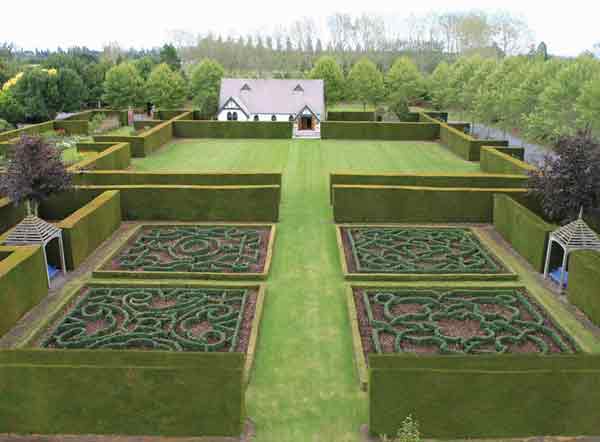 |
| The Knot Garden and chapel. Photo by Alan Trott |
A unique focus for the garden was created a decade ago when Alan purchased a defunct 1916 chapel in Ashburton and
moved it to one of the rooms in the formal garden. The immaculate old chapel, "complete with its original altar,
pews, and organ," hosts weddings and other happy occasions. Well-sheltered from winds gusting across the Canterbury
Plains, the chapel and garden induce a sense of peace and tranquility for visitors.
In the early 1900s, "races," or watercourses, for watering sheep were built all over the plains. The garden is outlined
on the northern edge by a stream, or "race," fed from the mountains; burnt orange and pink Primula reseed themselves
around the creek in late spring, flowering when the beautiful Siberian iris bloom. Water diverted from the stream
ebbs into the Pond, which is the focal point and most photographed area of the whole garden. White-barked birch trees,
rhododendrons and other shrubs and lawn outline the pond.
"Water attracts the eye," said Alan, "and I have some nice plantings around it - all foliage plants and large-leaved
plants for a dramatic setting." Six birch cultivars with amazing white bark are situated around the pond. In back of
the pond, a path permits a view from another vantage point. On the other side of the pond, a spacious lawn gives
strong emphasis without clutter. The large brass herons in the pond were a gift from a friend who closed her garden
and moved into a flat. The only other statuary is a garden sculpture Alan made out of fiberglass rods; it resembles
a tussock and stands three meters tall (ten feet). It is quite beautiful both undulating in the wind and when
calm.
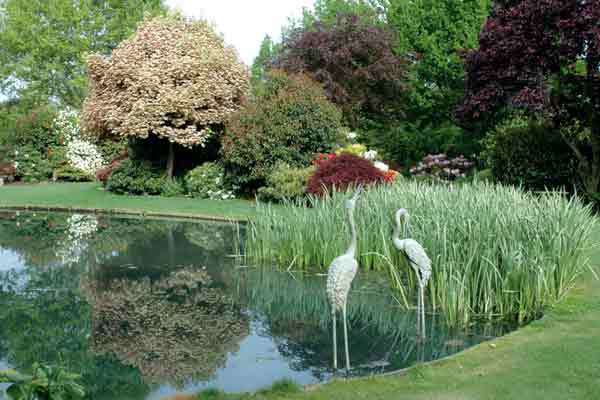 |
| Pond with statuary. Photo by Alan Trott |
Water trickling from the pond provides the moist habitat for Alan's Bog Garden, where enormous gunneras, hostas
and other moisture loving plants amaze visitors with their texture and colors. An archway of twenty-four Betula
'Silver Shadow' trees, accented by cypress hedges, leads to an elegant elevated belvedere and a wooden walkway
spanning the area from which vantage one can view across the Bog Garden to the formal garden area.
The Perennial Border is 110 meters long, double-sided, and filled with herbaceous plants. It is unique in that
it is not a mixed border. Alan also uses perennials around the garden for summer color. "You must have a garden
for all seasons; just rhododendrons can become a bit boring."
He has collected some eighty or more varieties of hostas. Favorites are 'Sum and Substance' and 'Blue Angel',
planted in big drifts to startling effect. Meconopsis can be difficult because they need summer moisture and
"heaps of compost." Summers, with temperatures reaching into the 32° C. (90° F) mark at times, are too dry
for them to thrive. Alan grows the Lingholm form, a cross between M. grandis and M. betonicifolia,
with its large stunning, intensely blue flowers.
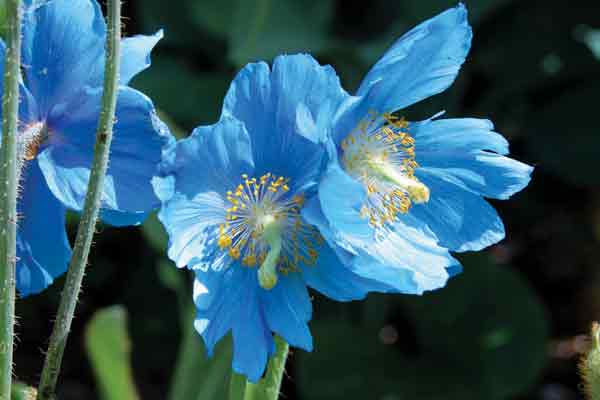 |
| Meconopsis 'Lingholm'. Photo by Alan Trott |
Large drifts of ornamental grasses, the variegated Miscanthus 'Morning Light' and 'Gracillimus', have
a special place in the garden. Alan enjoys them particularly in the winter when their dry blooms are
curled with frost. These he cuts down in very early spring to allow new shoots come up. To prevent the
blades of grass from scattering everywhere he binds them tight with a lasso before cutting, then tosses
the bundles on the trailer. Viburnum x macrocephalum is a show-stopper in the garden with huge
white snowballs. At 4 meters or more tall and massive in size, visitors acclaim it as the biggest and best
they have ever seen. Pink Viburnum plicata 'Rose Ace' is a winner also.
"A garden is not an object," informs Alan, "because things must change in a garden." In the last few years,
ever seeking new ideas, he planted the Red Garden, every plant with red foliage or flowers - a beautiful,
dramatic twist to a mixed border. He believes strongly that without good maintenance and an evolving
process, "a garden soon dies."
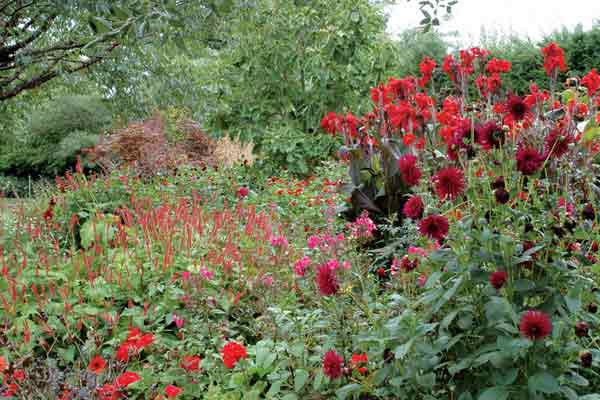 |
| The Red Border. Photo by Alan Trott |
The lawns are sprayed to kill grasses other than fescue and are mowed weekly by a retired friend on a
John Deere lawn tractor. With a persistent hoe, Alan controls weeds daring to move in. "If you keep on
top of it, it is not too bad to look after. I use Roundup in the garden if we have a week of wet weather
and you can't hoe that easily. I don't use a lot of fertilizer - we have amazing soil. Last year
we covered the Red Garden and perennial borders with a good dressing of compost."
The Lime Walk was formerly a path of climbing roses. Their high maintenance and their ubiquitous
"prickles" prompted Alan to replace them four years ago with firmly espaliered ornamental lime trees.
The walk curves into the gazebo and on around to enter the Red Garden. Roses have not fared well in
the garden. Of the original 256, only 12 remain.
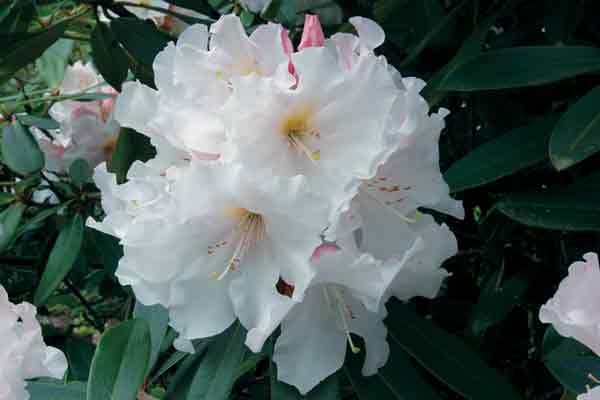 |
| R. 'Holmeslee Pearl'. Photo by Alan Trott |
The rhododendrons in the garden originally numbered 1200. Currently 650 from many countries grace the garden. Alan's favorite NZ hybrid is R. 'Holmeslee Pearl', hybridized by good friend, Graham Holmes, from some of the Ilam hybrids. "It has a fabulous truss and the petal texture is amazing; it's a winner in our garden." R. 'Irene Bain' (yakushimanum x 'May Day') is a choice NZ hybrid hybridized by the late Dr. Yeates, registered in 1979 by Irene Bain. Yeates was a past president of the NZ Rhododendron Association, and known for his Melford line of deciduous azaleas. Alan's preferences in a rhododendron include "good foliage on compact plants and good trusses. We are a bit hot and dry here in the summer and don't get the rain fall (680 mm (27 inches) annually) required by the big-leaved rhododendrons."
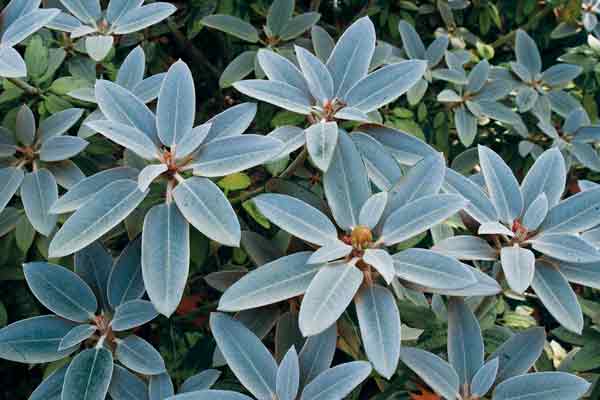 |
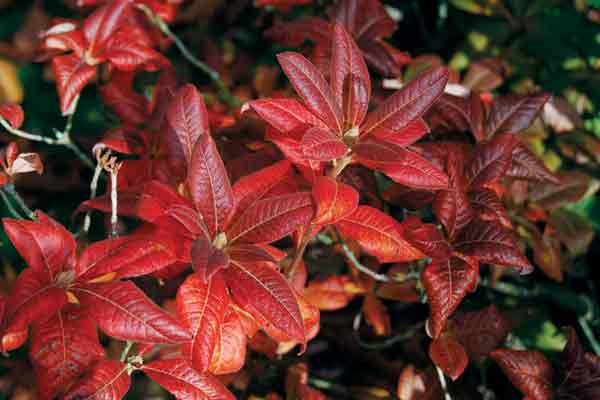 |
|
| R. pachysanthum. Photo by Alan Trott |
Azalea foliage. Photo by Alan Trott |
Trees are Alan's pride and joy. Favorites are Betula 'Silver Shadow,' Prunus serrula, and the Acers. The latter do well. With a collection of some 80 different cultivars, mostly Japanese maples, Alan expounds, "for their spring new-growth in all colors; they look good all summer and in the autumn, fired up with colors, they are magic." The birch collection was selected for their bark and year-round appeal. Alan believes that "trees with their form, bark and foliage give structure to any garden; without trees a garden is soulless."
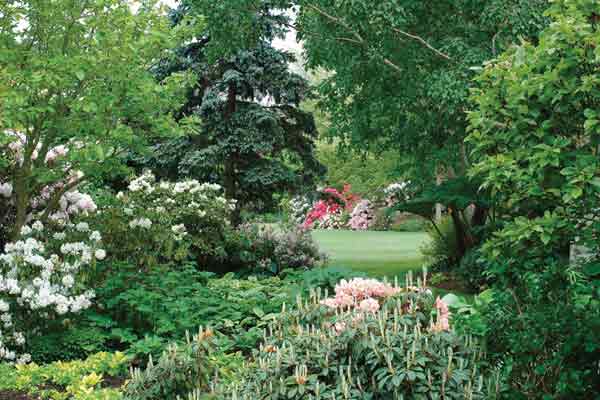 |
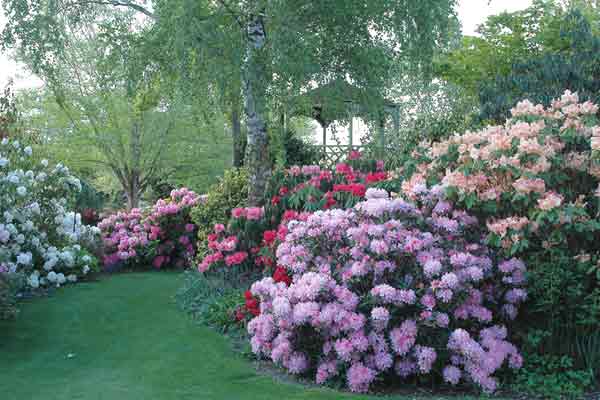 |
|
| Woodland area in spring. Photo by Alan Trott |
The Belvedere among the rhododendrons. Photo by Alan Trott |
Cherry blossoms are so fleeting that Alan replaced most of his trees with grafted Cornus
cultivars. Two species of Nyssa, N. sinensis and N. sylvatica 'Sheffield Park',
produce splendid autumn colors. The oaks are mainly seedlings but the Trotts have a good collection
of them. Quercus coccinea 'Splendens', a very good cultivar with "bloody red" color, is a
favorite. The variegated elm 'Frontier' with its upright form also puts on a lovely show of red
autumn color. Some fifty magnolias inhabit the garden, but despite their majestic structure, the
late frosts sometimes ruin the flowers.
Trees with outstanding bark are planted on the edges of the garden so folks can touch and admire
them. Alan's advice on planting trees: "Select only the best cultivars; planting on price or buying
seconds simply does not pay." Each autumn, Alan goes around with a pole saw and limbs them up so
"they will look spectacular!"
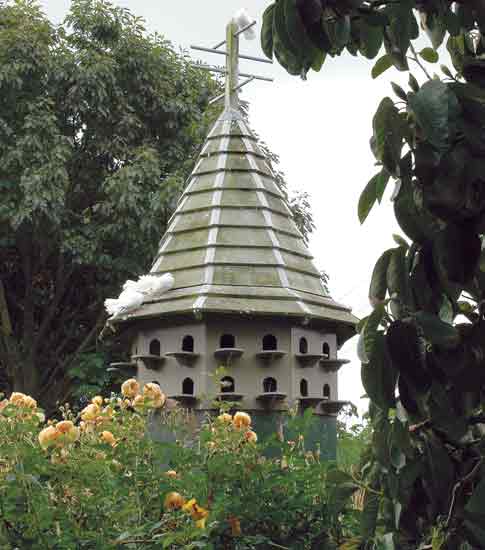 |
| The Dovecote. Photo by Alan Trott |
Two dovecotes (buildings that house pigeons or doves) add enchantment to the garden. One is a
20-year-old shingled double on a pole, and the other larger one, an impressive 4.1 m (13.5 ft) high,
was built in 2000. Graceful white fantail pigeons occupy them, their sounds and activities attract
much attention. A few native fantails live in the garden; wax-eyes come in the winter; magpies, thrush,
blackbirds and sparrows abound. A pair of gorgeous blue Indian ringneck parrots (Psittacula
krameri) breed in the aviary each year. Sharing the aviary is a large, tame, hand-reared white
cockatoo that "talks" gregariously to spellbound visitors.
A large veranda was built around the old wooden house when it was remodeled 18 years ago,
transforming it into a stylish comfortable home. Alan's collection of trilliums is planted around
it so he can enjoy "those little treasures." An old water well came with the house, but Alan soon
put in a 15 m (50-foot) well with a strong pump, furnishing good water for both the house and the
entire garden.
The old wooden barn with a loft contained loose stall boxes for draft horses many years past.
Though fairly basic inside, visitors love the old building. The shop contains Alan's greeting cards,
all taken with his D-80 Nikon camera, depict scenes from the garden. "I make up the cards and they
sell well. That, plus nursery, have been good for us - the cards are popular with garden visitors
who don't buy plants. I have also just printed some images on canvas and they look amazing!"
As Alan expounds, "Many good gardeners are self taught; we live in an age with amazing books and
travel opportunities. In planning the garden, I find most landscape architects know about design
but have little plant knowledge. I have always been interested in art and that helps." At present,
no plant records are kept, except in his head, but Alan is leaning strongly toward acquiring a GPS
system to document the location of his plants. Catherine has her priorities as well - golfing!
Hanging in the shop is Alan's favorite quote: "Far better to dare mighty things, to win glorious
triumphs, even though chequered by failure, than to take rank with those poor spirits who neither
enjoy much or suffer much, because they live in the grey twilight that neither knows victory or
defeat." Theodore Roosevelt, 1899
Reference
Salley, H.E., and H.E. Greer. 1986. Rhododendron Hybrids A Guide to their Origins. Timber
Press. Portland, OR: 391 pp.
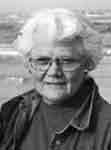
Frances Burns is a member of the Eugene ARS Chapter.